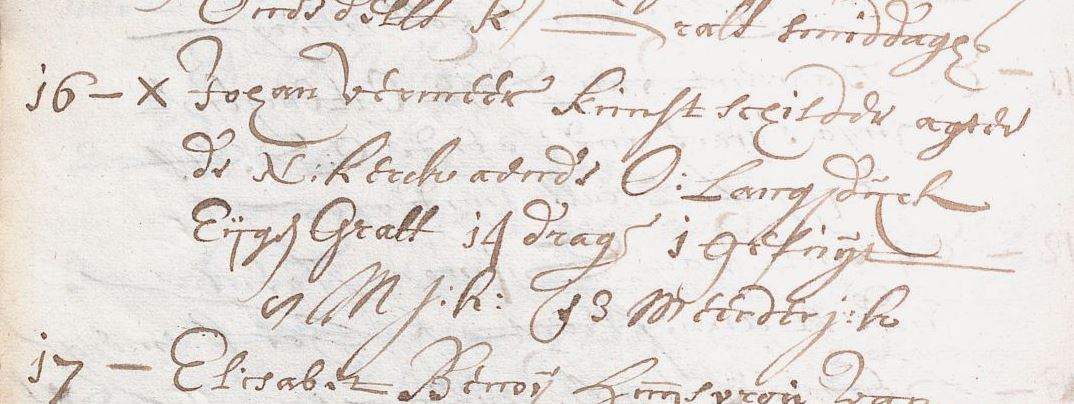Two new discoveries about the life of Johannes Vermeer (Delft, 1632 - 1675), the great seventeenth-century Dutch artist, have emerged during preparations for the exhibition Vermeer’s Delft that will be hosted by the Prinsenhof Museum in Delft, the painter’s hometown, from Feb. 10 to June 4, 2023. These are finds described as “extremely important” by the museum: former archivist Bas van der Wulp of “Erfgoed Delft,” the city’s cultural heritage department, found a hitherto unknown note about Vermeer in the burial register of the Oude Kerk (Old Church), which shows that the artist received a lavish funeral, while in an archive document on damage claims, employee Babs van Eijk discovered that Vermeer’s mother, Digna Baltens, received compensation for damages suffered at the “Herberg Mechelen” inn after the devastating disaster of the 1654 powder magazine explosion. New knowledge about Vermeer’s life is added with these discoveries. Both archival items can be seen in the exhibition from Feb. 10 to June 14, 2023.
Regarding the burial record, the hitherto unknown mention of Vermeer in a burial register of the Oude Kerk, where the artist is buried, states that at Vermeer’s funeral on December 16, 1675, the coffin was carried by no less than fourteen bearers and that the church bell rang for a time. The exact record of the burial reads as follows: “December 16 (1675): Johan Vermeer, painter behind the N[ieuwe] Kerck aen de O[ude] Langendijck. own grave. 14 bearers, 1 bell ringing. 8 minor children, 3 adult children.” According to Van der Wulp it must therefore have been a very luxurious funeral: no similar ceremonies have been found for other artists. However, Vermeer’s brother-in-law, Willem Bolnes, who died in 1676, received exactly such a funeral, and similar obsequies were also arranged for Vermeer’s mother-in-law, Maria Thins, who died a few years later, except that for her the bell rang two ’tenses’ and not just one. It is therefore suspected that Vermeer’s funeral was paid for by his mother-in-law. “Probably the mother-in-law only wanted to advance the expenses of Vermeer’s funeral to her daughter,” says Van der Wulp, “and at that time she was not yet aware of the miserable financial situation Vermeer had left behind: three years after the Disastrous Year 1672, Vermeer was penniless.”
The discovery of the funeral note can be considered remarkable, according to the Prinsenhof Museum, in light of the extensive research on Vermeer done by so many scholars for over a hundred years. For example, Van der Wulp, who has worked for the archive for 45 years, has never made such a discovery before. Janelle Moerman, Director of the Prinsenhof Museum, says in this regard, “So much research has already been done on Vermeer that everything found on the artist is already known. Each discovery adds, so to speak, a piece to the puzzle about the life of Delft’s most famous master.”
As for the second document, however, during the devastating Delftse donderslag (the “Delft Thunder”) of October 12, 1654, or the explosion of the local powder magazine, the inn run by Vermeer’s mother also suffered damage, and the city council awarded her compensation. It was indeed Digna who was in charge of the family’s restaurant business after her husband’s death and was still living there at the time of the devastating explosion of the powder magazine. The archival document with damage reports was known, but not that Vermeer’s mother had received compensation.
Both documents, as mentioned, will be presented at the exhibition Vermeer’s Delft, which focuses on the painter’s life, his social network, and his relationship with the city of Delft. Based on more than 100 objects from the Netherlands and abroad, including masterpieces by Delft painters, applied arts, maps, prints, drawings, books, ego documents and other archives, a picture of the vibrant urban climate in the 17th century is sketched. The exhibition runs parallel to the major Vermeer exhibition at the Rijksmuseum, also scheduled from Feb. 10 to June 4, one of the most anticipated exhibitions of 2023.


 |
| Two new facts about Johannes Vermeer's life discovered |
Warning: the translation into English of the original Italian article was created using automatic tools. We undertake to review all articles, but we do not guarantee the total absence of inaccuracies in the translation due to the program. You can find the original by clicking on the ITA button. If you find any mistake,please contact us.